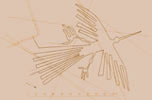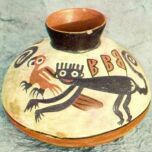

Association "Dr. Maria Reiche - Lines and Figures of the Nasca Culture/Peru"

Youth |
In Peru |
The Lines |
Working at the Pampa |
Nasca |
Protection for the desert |
Nasca – a little town at the Panamericana with about 23.000 inhabitants – wouldn’t be important without the near soil drawings. Since years the tourism is on the boom. Numerous hotels and restaurants save the livelihood and travel agencies sell flights over the desert. But the name Nasca doesn’t mean only the lines. The Nasca-culture, which developed between 200 BC and 800 AC in the southern coastal region, left fantastic woven goods and painted ceramics behind. Scenes of the daily life and creatures out of a mythical and religious world were portrayed in glowing earth colours. Some of the pictures, like the monkey, you can also see in the desert as geoglyphs.The inhabitants of the coastal region buried their dead persons wrapped in ornate grave cloths and in a crouching position. They have preserved as mummies in the dry sand. But unfortunately lots of the graves around Nasca fell victim to plunderer. Furthermore the "Nascas" were masters for irrigation. Cleverly devised and partly underground canal systems are used until today by the agriculture of the wide river oasises. |